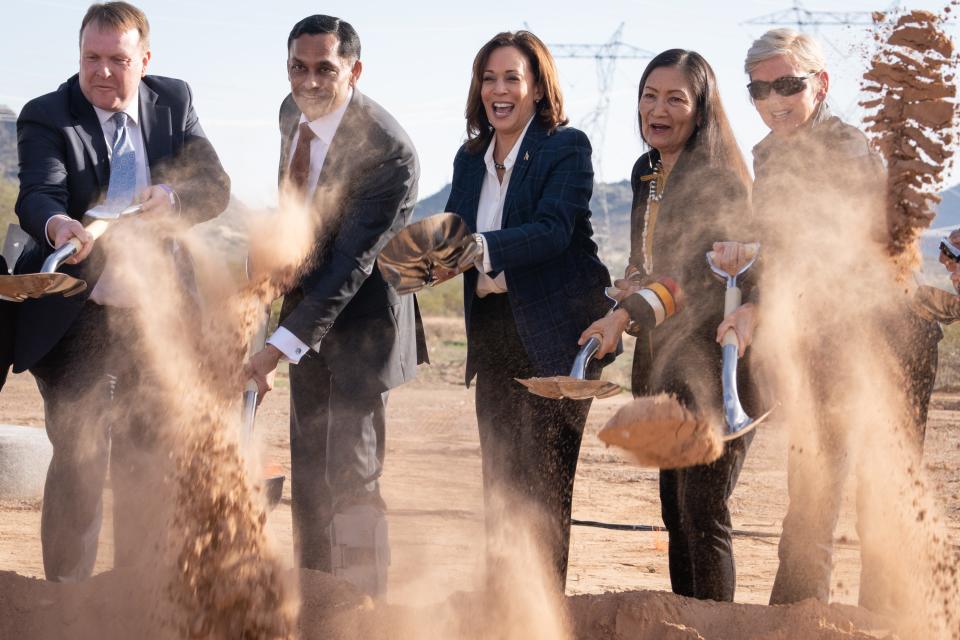'Historic transition': Vice President Kamala Harris makes case for clean energy at AZ transmission line groundbreaking
Vice President Kamala Harris came to Tonopah on Thursday afternoon to showcase the Biden administration's investments in clean energy.
In her first official visit to Arizona as vice president, Harris attended the groundbreaking of the 125-mile-long Ten West Link transmission line, which will help transport wind and solar energy to the Phoenix area and Southern California.
Harris arrived in Tonopah at 2:56 p.m. for a briefing on the substation project from IBEW workers. Kyle Gladden, the site foreperson, told the vice president that the Ten West Link was almost halfway through the 18-month construction process. A helicopter installs some of the string in the line to avoid disturbing the environment, Gladden was heard to say.
Harris was joined by Interior Secretary Deb Haaland, Energy Secretary Jennifer Granholm, National Climate Adviser Ali Zaidi and Arizona Gov. Katie Hobbs.
The Ten West line will link electrical substations in Tonopah and Blythe, California. The line will go along the same route as the Devers-Palo Verde 500 kV transmission line, which runs from Tonopah's Harquahala Substation to the Devers Substation in North Palm Springs, California. It traverses public land managed by the Department of the Interior's Bureau of Land Management and Bureau of Reclamation as well as the U.S. Army's Yuma Proving Ground.
About 120 people were at the Ten West Link construction site for Harris' remarks and the ceremonial groundbreaking.
“Arizona, I am here today because this project demonstrates a very important point. It shows when we invest in climate we also invest in families, in communities, in opportunity and prosperity for all people," Harris said. "When we invest in climate, we invest in America."
Harris began her 11-minute remarks at 3:31 p.m., making an economic argument for clean energy by saying it's cheaper to transmit solar and wind electricity than electricity generated from fossil fuels. She also argued that clean energy creates good-paying, union jobs. She broke ground for the project at 3:42 p.m.

"The Ten West Link transmission line will stretch from Arizona to California. It will deliver electricity from wind and solar farms out here in the desert, to big cities like Phoenix and Los Angeles and San Diego, and to rural communities like Blythe and ... Quartzsite," Harris said. "This electricity will be clean electricity. Solar panels and wind turbines do not produce toxic fumes that poison our air or dangerous chemicals that poison our water.
"And the energy delivered by these lines will not just be cleaner, it will also be cheaper. On average, you see, clean electricity is less expensive than electricity generated from traditional sources," she said.
The transition to transmission lines "means more clean energy for our communities," Harris added. "And that means more money in the pocket of the American people, more money to buy groceries, to invest in home repairs, to pay for your kid's college, and to save for your retirement."
Harris talked about going on road trips as a kid. She and her sister would play games such as counting the number of VW Bugs while marveling at the amount of electric lines crisscrossing the sky.
“Today, America has more than half a million miles of electric lines, enough to wrap around the globe 24 times," she said.
The United States is "at the start of a historic transition … toward cleaner and safer energy sources," Harris said.
The link project is "groundbreaking for the region," said Hobbs, who spoke along with Zaidi, Granholm and Haaland.
Haaland discussed how the project will boost a bulk power system for Arizona and California. She said the clean-energy projects under the Bipartisan Infrastructure Law and the Inflation Reduction Act are "once in a generation investments."
BLM gave the link project the go-ahead in November 2019 and construction was approved in July. The Ten West Link is projected to be up and running by the end of next year.
The Ten West Line will be able to send 3,200 megawatts of solar energy and will be able to be linked to any future clean energy initiatives in the area.
The Biden administration also touts as its accomplishments the 2022 Inflation Reduction Act, along with components of the CHIPs and Science Act, the 2021 Bipartisan Infrastructure Law, along with executive actions, form the core of Biden's climate change policy.
The Inflation Reduction Act authorizes $370 billion dollars to fight climate change. The law also includes funding to improve the national power grid, with approximately $3 billion earmarked for transmission funding initiatives such as the Ten West Link.
The project is part of the administration's objective to lower U.S. greenhouse gas emissions in half by 2030 from 2005 levels, which was a little less than 6,000 million tons.
Air Force 2 touched down at 12:37 p.m. at Luke Air Force Base. On the tarmac were Haaland, Granholm, Hobbs, U.S. Rep. Ruben Gallego, D-Ariz., and several Luke officers.
At the same time Harris was in Tonopah, second gentleman Douglas Emhoff was supposed to take part in a roundtable discussion at Arizona State University about combating antisemitism. That event was closed to the media.
Later in the day, Harris was expected to meet with service members at Luke Air Force Base before she and Emhoff headed to Los Angeles.
Tara Kavaler is a politics reporter at The Arizona Republic. She can be reached by email at [email protected] or on Twitter @kavalertara.
This article originally appeared on Arizona Republic: Kamala Harris makes case for clean energy in Tonopah visit
